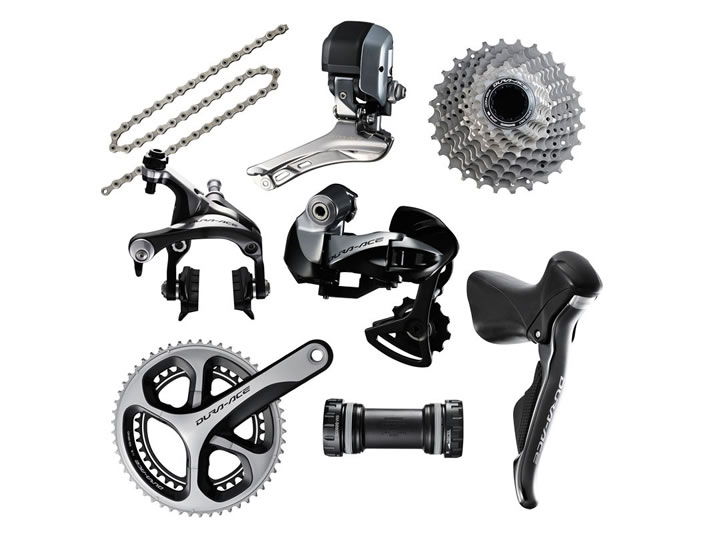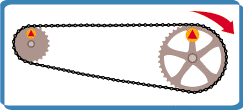| Home | Introduction |
Aerodynamics | Materials of Bikes |
Power &
Energy |
Bibliography |
How does the gearing in a bike work?

Shimano Dura-Ace Di2 (electronic) drivetrain components, parts include STi shifters, chain, front/rear derailleur, crank, brakes, rear cog cassette, and bottom bracket
Photo Courtesy of http://www.bikebug.com
Gearing on a bicycle is very similar to that of gearing in a car's transmission: there are different combination in order to get a specific ratio.
In a bike drive train, there are two components that make up the gearing ratio: one is the crank, the part the rider applies a force to and normally has 2 or 3 gear settings; the other is the rear cassette with 8-11 cogs.
Most bikes these days have around 15-27 different gearing combinations; however, most riders will not use all of these available combinations as some provide the exact same ratio as other (limiting the amount of actual ratio without duplicates)
How exactly does gears benefit me? (Physics explanation)

An example of a gear ratio with a big chainring and small cog
Animation Courtesy of http://www.exploratorium.edu
Many people question "why do I need so many gears?" The answer to that is that it allows a rider to go on different terrains (varying in slope) as well as have a higher max speed. When you look at specific gear ratio, some are seen to be better for hill climbing while others are better for top speed on the flats. These ratios can be explained with the physics of mechanical advantage and the idea of work/torque.
When riding a road bike with a 10-speed rear cassette and a 2-speed crank, one will find that at the extremes, having the bike in the biggest chainring and the smallest cog in the cassette will have the highest top speed but be very hard to get a good start from whereas the opposite occurs when they are in the biggest cog on the cassette and smallest chainring in the crank.
The explanation to this is that when a rider is low gear (big rear gear/small front gear) they have to input a small amount of force (torque) over more revolution; this however, allows the big cog in the back to produce a large amount of torque over a smaller amount of revolutions. Therefore having a smaller gear ratio like this produce a great amount of torque which is great for climbing uphills however, isn't very effective for getting a high speed.
In the other case where one is in a big chainring and small cog cassette therefore having a high gear ratio, one will be able to hit a higher top speed at the cost of having a smaller amount of torque. The explanation to this is that one must input a high amount of torque over less rotations with the benefit of having a small amount of torque with more rotations at the wheel. Having more rotations at the wheel with a small amount of rotations at the power source leads to higher top speeds.